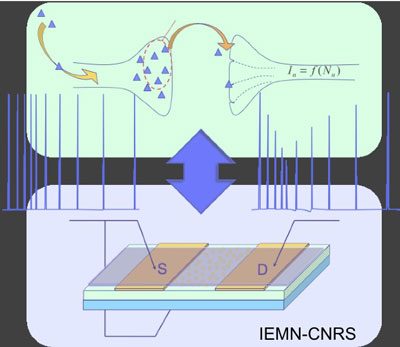NOMFET – an organic transistor that mimics a brain synapse
 Scientists have great expectations that nanotechnologies will bring them closer to the goal of creating computer systems that can simulate and emulate the brain’s abilities for sensation, perception, action, interaction and cognition while rivaling its low power consumption and compact size. Nanotechnology researchers in France have developed a hybrid nanoparticle-organic transistor that can mimic the main functionalities of a synapse. Nanoparticle Organic Memory Field-Effect Transistor (NOMFET) has opened the way to new generations of neuro-inspired computers, capable of responding in a manner similar to the nervous system.
Scientists have great expectations that nanotechnologies will bring them closer to the goal of creating computer systems that can simulate and emulate the brain’s abilities for sensation, perception, action, interaction and cognition while rivaling its low power consumption and compact size. Nanotechnology researchers in France have developed a hybrid nanoparticle-organic transistor that can mimic the main functionalities of a synapse. Nanoparticle Organic Memory Field-Effect Transistor (NOMFET) has opened the way to new generations of neuro-inspired computers, capable of responding in a manner similar to the nervous system.
“Basically, we have demonstrated that electric charges flowing through a mixture of an organic semiconductor and metallic nanoparticles can behave the same way as neurotransmitters through a synaptic connection in the brain,” said Dominique Vuillaume, a research director at CNRS and head of the Molecular Nanostructures & Devices group at the Institute for Electronics Microelectronics and Nanotechnology (IEMN).
In the development of new information processing strategies, one approach consists in mimicking the way biological systems such as neuron networks operate to produce electronic circuits with new features. In the nervous system, a synapse is the junction between two neurons, enabling the transmission of electric messages from one neuron to another and the adaptation of the message as a function of the nature of the incoming signal (plasticity). For example, if the synapse receives very closely packed pulses of incoming signals, it will transmit a more intense action potential. Conversely, if the pulses are spaced farther apart, the action potential will be weaker.
“This is a fundamental property of the synapse behavior called STP (short-term plasticity)” explains Vuillaume. “In our NOMFET, the presynaptic signal is the pulse voltage applied on the NOMFET and the output signal is the drain current. The holes – the charge carriers in the p-type organic semiconductor used here – trapped in the metallic nanoparticles play the role of the inhibited neurotransmitters. The number of trapped holes in the nanoparticles depends on the input spike voltage and the output signal, the current, is a decreasing function of the number of holes stored in these nanoparticles – because less holes are available to transmit the current through the NOMFET.”
In other words, the encapsulated gold nanoparticles, fixed in the channel of the transistor and coated with pentacene, have a memory effect that allows them to mimic the way a synapse works during the transmission of action potentials between two neurons. This property therefore makes the electronic component capable of evolving as a function of the system in which it is placed.
The potential application of this work is to increase the performances of neural-network computing circuits. Moreover, nanoparticles and molecules are nanosize objects suitable for nanodevice fabrication; they can be manipulated and assembled by low-cost, bottom-up, techniques (e.g., self-assembly); and they are prone to work on flexible, plastic, substrates.
Vuillaume points out that this later feature might be advantageous if we envision connecting artificial neuromorphic devices and circuits (based on the NOMEFT) with soft biological materials. However, he also notes that, even if this work reduces the number of electronic devices required to mimic a biological synapse, the high level of synapse-neuron connectivity in the brain requires the development of artificial neural networks computing circuits in 3D.










NOMFET is a Nanoparticle Organic Memory Field-Effect Transistor. The transistor is designed to mimic the feature of the human synapse known as plasticity, or the variation of the speed and strength of the signal going from neuron to neuron. The transistor uses gold nano-particles of about 5-20 nm set with pentacene to emulate the change in voltages and speed within the signal. The recent creation of this novel transistor gives prospects to better recreation of certain types of human cognitive processes, such as recognition and image processing. When the NOMFET is eventually applied, it should be able to replicate the functionality of plasticity that previously required groups of several transistors to emulate and thus continue to decrease the size of the processor that would be attempting to utilize the computational advantages of a pseudo-synaptic operation.
Connecting artificial neuromorphic devices and circuits (based on the NOMEFT) with soft biological materials will open new Vistas in Computer science. As such the research by Scientists in France is a major contribution to the Computer field.
Dr.A.Jagadeesh Nellore(AP),India
i want some annalysis done by u
Keeping a fresh blog is hard and quite tiresome. You might have pulled it off well though.